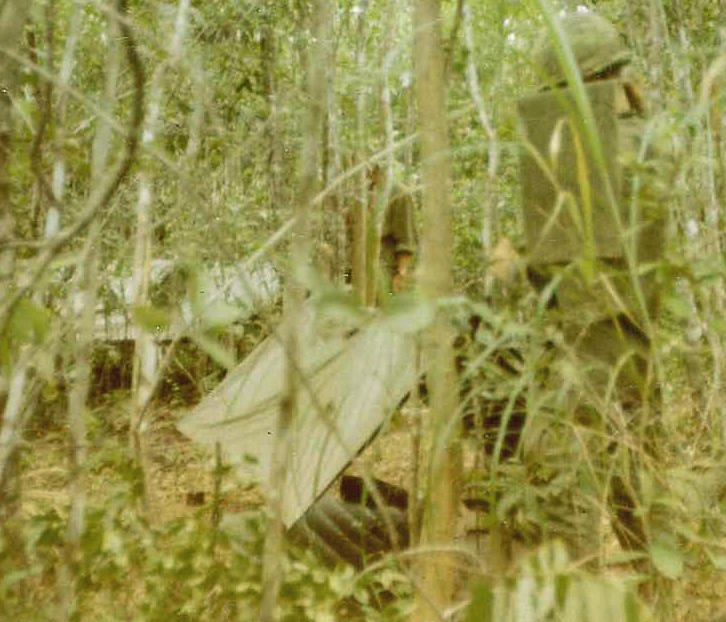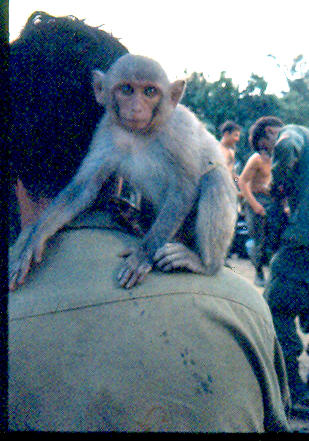![]() 1st Battalion 22nd Infantry
1st Battalion 22nd Infantry ![]()
The Jungle
The sniper
C Company 1/22 Infantry stayed in the jungle between An Khê and Binh Khê for nearly two months in late 1970. We humped everything we needed on our backs, finding or making a clearing every 4 or 5 days for re-supply by helicopter. High in the mountains we took water from streams, filling our canteens and adding purification tablets and packets of Kool Aid we had folks from home send us to kill the horrible taste of the tablets. At times we would come across nothing but water too foul to use or no water at all. Then the helicopters would sling huge black rubber blivets with potable water and bring them with the re-supply. The blivets were big 500 gallon tanks of water with a spigot on one side to allow the water to flow out into our canteens.
At one LZ (Landing Zone) on the top of a ridge line, a few hours after we had received our re-supply “Utah” and I were detailed to fill the canteens for our squad. One of the big blivets had been set down in the landing zone to supply us with water.
The LZ had been cut by hand by us and Engineers who had been flown out to help. To clear the landing zone of jungle we used axes and chainsaws brought by the Engineers along with our machetes. A number of trees were blown down with C-4 plastic explosive. The blivet was away from the center of the LZ next to a large pile of cut down limbs and branches and tree trunks.
We had finished filling the canteens and were standing about three feet apart when a sniper in the opposite tree line fired a shot that went literally right between me and “Utah”. The shot passed so close I felt my shirt move from the air the bullet displaced as it travelled supersonically between us. “Utah” later said he felt the heat from it. I don’t know if the heat from a bullet can actually be felt, but at least what he said meant he felt it too and I wasn’t just imagining it.
We dove into the pile of limbs just as the sniper’s second shot cracked overhead. His third shot smacked into the limbs and made us burrow deeper into the tangle of branches, nearer to the ground. Our frantic scramble to get inside those limbs and branches left both of us in extreme unnatural positions with our arms and legs bent at awkward angles and pointed in different directions as we tried to become liquid in our attempt to hide inside those branches. We looked so ridiculous that we both couldn’t help it and we burst out laughing at each other for a minute before we untangled ourselves and got on the ground against the pile, shielded from the sniper.
The guys in the tree line on our side of the LZ yelled out to stay put. But we weren't going anywhere. We each had a rifle and a bandoleer of ammo, a pack of cigarettes, all the water we wanted and were behind excellent cover. We figured to stay there all day, no problem.
About ten to fifteen minutes later we heard brush breaking in the jungle on one side of the LZ, halfway to the sniper's treeline. Then a lot of brush breaking and even chopping and hacking. Then a whole lot of shouted curses. It was the unmistakable voice of Livingston our squad leader for 1st squad. He was a Southern boy and we Southern boys have a knack for colorful language but Livingston was teaching us all a few new things in the stuff he was yelling. Utah and I laughed hard for we knew what had happened. Livingston had led the rest of our squad around the LZ to go get the sniper but had run into jungle growth so thick they couldn't get through it. It really upset him to not be able to get through it and get that guy.
After things quieted down the sniper popped off another round just to let us know he was still there. Half an hour or so after that the guys yelled out to us to get ready to run toward our side of the LZ. They were calling in artillery on the opposite tree line and would lay down cover fire with M-60's for us. They would stop and hold fire long enough for us to make it to the safety of the trees. Four M-60 machine guns opened up, raking the jungle across the LZ, and when they stopped firing the guys started yelling for us to move, but we were already up and running. The last ten feet I flew through the air, landing on my stomach next to a gunner from 2nd Platoon, who resumed firing before I hit the ground. Not but a few seconds later the artillery began impacting on the far side of the LZ. Sometime after it finished our Lieutenant led a patrol across the LZ and into the jungle on the opposite side but found neither hide nor hair of the sniper.
Dodd "Utah" Owens Photo by John Bryce |
---------------- |
Huey Livingston on the left, Photo by Bo Bonnema |
Monkey in the foxhole
Third Platoon Charlie Company 1/22 Infantry was in the jungle between An Khê and Binh Khê during September and October of 1970. Mostly we moved on trails all day long, stopping at around 4 or 5 in the afternoon to set up an NDP (Night Defensive Perimeter) where we would spread out in a circle amongst the jungle growth, vegetation and trees, and stay the night. We would ring the perimeter with foxholes, three guys to a hole. Not far behind the hole we would snap two ponchos together and stretch them over branches to make a tent, which we called a “hooch”, with a third poncho as ground cover. Each guy would take his turn in the hole on guard duty, usually 2 or 4 hours at a time, then crawl back to the hooch to wake up the next one for his turn.

This is us (3rd Platoon)
in the jungle 1970. In the foreground are ponchos stretched over
cut branches to make a “hooch” (tent).
An air mattress can be seen on the ground inside the
“hooch”. This is a thin part of the jungle without the
usual triple-canopy of treetops
overhead to block out the sky. In those areas under the triple
canopy there was no moonlight and at night everything was so dark
there was no vision. Nothing could be seen, no matter how close.
It was pitch black in the jungle at night, so dark I couldn't see my hand in front of my face. Guard duty consisted of listening for sounds. Asleep in the hooch I was awakened by Lewis at about 2am for my next turn and as we moved by each other he whispered in my ear "There's a monkey in the foxhole." I managed a groggy "What?" but he was already in the hooch and out to sleep. I took my position sitting on the edge of the hole with my rifle across my lap and my legs hanging inside the hole. After eating we would toss our empty and half eaten c-ration cans down in the bottom of the foxholes, in one corner, so that when we moved out in the morning and filled in the holes, the litter we left behind would be buried, so the NVA (North Vietnamese Army) couldn't use any of it.
About ten minutes after starting my turn on guard there came a noise from my left, the sound of metal clinking. It scared the hell out of me when I realized it came from the end of the foxhole I was sitting in. Then I remembered what Lewis had said. I was sharing the hole with a monkey, four or five feet away from me. It was too dark to see him, but from the sounds he was making I could tell that he was going through our discarded food cans and eating the scraps and remnants from them.
At first it was kind of neat to have the little fella there, but he was sure making noise as he would go through the cans. And when he was finished with a can he would throw it down in the hole, hitting other cans and making more noise. To me it seemed like he was making as much noise as a full brass band and was giving away my exact position to the entire North Vietnamese Army. Not good.
For an instant I thought of shooting him, but I couldn't even see him, and for all I knew I might hit the guys in the next hole instead, besides telling the NVA exactly where everybody was. I scooped up a handful of dirt and threw it in his direction. He made little pitter-patter sounds as he scurried out of the hole. All was quiet for about ten or so minutes, then he was back going through the cans again.
This went on intermittently for the rest of my turn, and at one point he threw down a can and hit me square in the leg. I had to calm down, knowing that even if I managed to jump on the little SOB in the dark and strangle him, he would have hurt me bad in the process, and they don't give Purple Heart Medals for being torn up by a monkey. When it was time I crawled back to the hooch and woke up “Utah” for his turn at guard. I felt his shoulder, got close and whispered to him "There's a monkey in the foxhole." In seconds I was asleep and out like a light.
The next afternoon as we were setting up our next NDP, the three of us all talked about the monkey, and how he had scared, aggravated and angered us one by one through the night.

Vietnamese Rhesus monkey
on the shoulder of an American G.I. This one is young but full
grown this species didn’t get too much bigger than this.
Even if they had a sweet disposition they were still basically a
wild animal. If you scared him or got him mad, this little guy
could and would
bite off a couple of your fingers.
Photo from David Ondrejko who was in Company B at the same time I was in Company C.

Standing, left is
Charles Lewis, mentioned in above story. A week or so after the
monkey incident while we were
still out in the jungle he came down with malaria. Racked with
fever he shivered and sometimes violently shook all night long.
We covered him with our poncho liners and a poncho but he still
shivered non-stop as if he was freezing cold. Next morning we got
a
medivac helicopter out to us and they brought him back to the
hospital at the Base Camp at An Khê. This photo was taken
in the Company area at the Base Camp about a month or so later
when he was back with us on full duty. Also in photo, squatting
down
in front is Dodd “Utah” Owens, who is also mentioned in
above story.
Copyright © Michael Belis 2020
All rights reserved
Home | Photos | Battles & History | Current |
Rosters & Reports | Medal of Honor | Killed
in Action |
Personnel Locator | Commanders | Station
List | Campaigns |
Honors | Insignia & Memorabilia | 4-42
Artillery | Taps |
What's New | Editorial | Links |